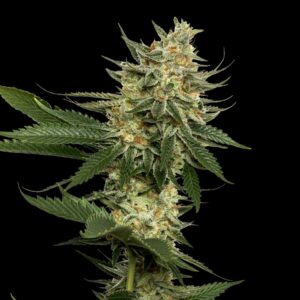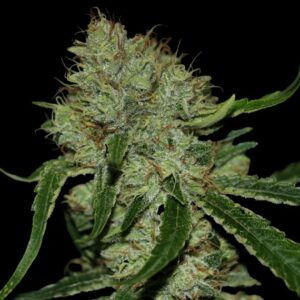What are Sativa Cannabis Seeds?
Sativa seeds are a cornerstone of the cannabis world.
They hold the genetic code for growing Sativa cannabis—tall, slender plants with narrow leaves and powerful, uplifting effects. Pure Sativa seeds yield a high flower-to-leaf ratio and have a flowering period that can last for several months.
Sativas thrive in warm, sunny climates found in Central America, Africa, and Southeast Asia.
Why Choose Sativa Seeds?
Sativa is the top choice in the cannabis market. For growers, the strain provides impressive yields and long harvesting windows. And enthusiasts get to enjoy high THC levels with energizing effects other types can't match.
The Indica vs. Sativa Difference
Here's a closer look at how Sativa seeds and plants compare to one of their fiercest competitors in the cannabis market, Indica.
| Strain | Leafs | Stature | Flowering time | Compounds | Effects |
|---|---|---|---|---|---|
| Sativa | Light color, long, and thin | Slender | 10–16 weeks | More THC | "Head high", alertness, uplifting |
| Indica | Deep color, short, and wide | Bush-like | 8–12 weeks | More CBD | "Body high", relaxation, pain relieving |
The Unique Effects of Sativa
In sync with the warm climates and sunny days this plant adores, Sativa delivers energizing sensations that many argue can't be experienced with any other variety.
Sativa effects include:
- Heightened creativity, alertness, and motivation
- Increased energy and uplifted mood
- Improved focus
Best Sativa Cannabis Seeds
Sativa seeds come in various forms, each with unique characteristics and effects.
Feminized Sativa Seeds for Guaranteed Females
Feminized seeds ensure that the resulting plants will be female, securing plentiful harvests.
Best Feminized Sativa seeds for sale: Green Crack, Blue Dream, Purple Chocolope, and Sour Garlic x Honey Banana. These exciting types are all about fruitiness and sweetness, with Purple Chocolope offering a perfect hint of coffee and Sour Garlic x Honey Banana adding a touch of spiciness. Another perfect hint lies in the effects of these strains—true to their original Sativa roots—they boost creativity, provide a burst of energy, and uplift overall mood.
Autoflower Sativa Seeds for Faster Harvests
Autoflower seeds produce plants that flower regardless of the light cycle, enabling you to harvest earlier and multiple times throughout the season.
Regular Sativa Seeds for Traditional Cultivation
If you prefer a natural approach to growing your Sativa seeds, you can still achieve excellent results with strains that thrive in traditional cultivation settings.
Best Regular Sativa Seeds for sale in the USA: Tangie and Tangelope Kush share their names but also fantastic aromas and effects. With high THC content of around 23% for Tangie and 18% for Tangelope Kush, both provide citrusy aromas and creativity spikes, offering a one-of-a-kind experience.
Growing Sativa Seeds: Indoor or Outdoor?
Both indoor and outdoor cultivation have their respective advantages and challenges.
Indoor Sativa Cultivation
Indoor cultivation of Sativa seeds provides precise control over the growing environment, which is especially beneficial in areas with limited sunny days. When executed correctly, indoor cultivation allows for year-round growth.
Sativa plants' tall stature can pose challenges because of indoors' limited vertical space for growth. Techniques like pruning and training can help you tackle this issue.
Outdoor Sativa Cultivation
Opt for outdoor Sativa cultivation if you have a spacious outdoor area and access to plenty of direct sunlight for at least six months a year. This provides Sativa plants with natural light, one of the primary necessities for their robust growth.
The cons include risks of pests and wind damage. To mitigate these, implement proper pest management techniques and provide adequate support, such as trellises, to protect your Sativa plants from strong winds.
In short:
- If you have limited sunny days or want precise environmental control and year-round growth, go with indoor Sativa seeds cultivation.
- Growing outdoors might be better if you have lots of outdoor space and plenty of sunlight.
Steps for Growing Sativa Plants
The saying that everything good is worth the effort holds true for growing cannabis Sativa seeds into plants. While requiring a bit of time and effort, the final results are worth it.
Essential steps for growing your Sativa successfully:
1. Choose the right Sativa seeds
Buy Sativa seeds from reputable and dependable providers. Look for seeds with high THC content and clearly labeled as Sativa strains.
2. Germinate seeds
Place cannabis Sativa seeds on a moist paper towel inside a plastic bag and leave them in a sunny spot until roots emerge. Then, plant them in a 2-inch (5 cm) container with the taproot facing down.
3. Determine the ideal location
Pick your growing areas carefully. Sativas need to receive plenty of sunlight, ideally at least six hours per day.
4. Ensure adequate nutrients
Test soil for pH—you'll need a pH of 5.5 for indoor cultivation and 6.5–7.0 for outdoor growth. When it comes to nutrients, nitrogen, phosphorus, and potassium are essential.
5. Transplant seedlings
After your Sativa seeds have sprouted and grown into seedlings, transfer them into larger pots or outdoors.
6. Establish a watering and maintenance routine
Water Sativa seeds every two to three days or when the soil feels dry about an inch (2.5 cm) down. Watch for nutrient deficiency or pest signs, and support plants with trellises.
Top 5 Tips for Growing Sativa Plants
Here are expert tips to help you get the most from your Sativas.
- Maintain temperatures below 85°F (29°C) and humidity between 55–65 RH.
- For faster maturation, shorten day lengths to eight hours in the final weeks before harvest.
- If the soil pH isn't high enough for growing Sativas, add materials like wood ash or limestone. To lower the pH, use aluminum sulfate or iron sulfate.
- Cannabis Sativa seeds require nitrogen, potassium, and phosphorus for healthy growth but thrive best when the soil has more nitrogen than the other two.
- Don't overdo fertilization. Too many nutrients can harm Sativa's aroma and flavor profiles.
Where to Buy the Best Sativa Seeds in the USA?
Best Sativa seeds boast abundant yields of THC-rich plants that evoke warm, tropical sensations while boosting energy and focus.
DNA Genetics offers precisely such high-quality Sativa marijuana seeds for sale. With decades of experience and awards, our seeds reflect an everlasting commitment to providing the finest cannabis strains.
Explore our Sativa seeds for sale now, or contact us with any queries.



